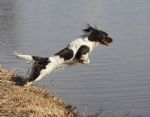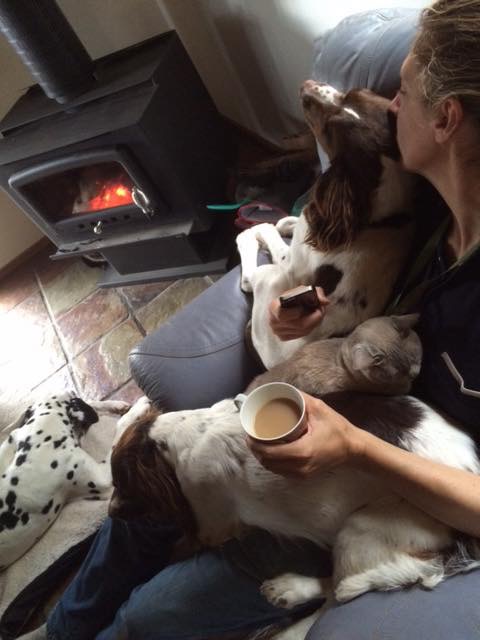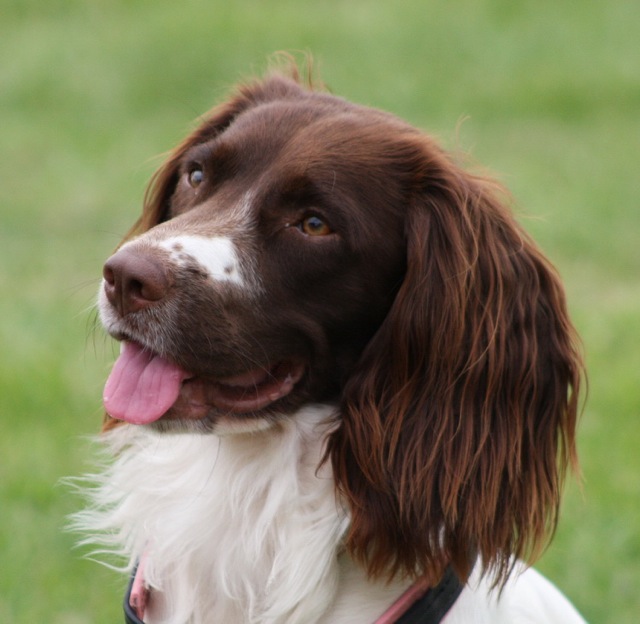Living with field-bred ESS
As we can't possibly speak for every owner of field-bred ESS, we will try to describe what it's like for us.
Our dogs do not live in kennels but in the house with us from the day they enter our lives or, in the case of pups we breed, from the day they are born. We prefer to see our pups go to homes where they are allowed indoors and are part of the family - we think both the owner and the pup benefit, particuarly with today's busy lifestyles. Unless you spend much of your day outdoors a dog relegated to the backyard may only recieve minimal contact. The current research suggests that dogs generally prefer human interactions over dog-dog interactions, particularly when in stressful situations. So whilst we have multiple dogs we find they would much rather train with us rather than play with each other. Our dogs love to be close by - part of that is the nature of the breed but it's also how we raise them with consistent, gentle handling from Day 1 by a variety of adults and children. Our dogs are great company - whether we are excercising them, training, competing, on the road, camping, curled up in front of the fire in Winter or enjoying a relaxed lunch at a local pub in Summer. Whilst I am typing this missive, Em is lying across my lap and young Ginny is chewing her deer antler at my feet.
Em and Ginny (field-bred ESS) and Ziggy (Dalmatian) also share the house with our cats, Lilly (Burmese) and foster kitten turned foster failure, Dizzy (Abyssinian X). The cats and dogs live very harmoniously although of course the young dogs just want to play all the time. We have also cared for and trained several puppies belonging to friends so our cats are well used to "running the show" and eventually the novelty wears off. We are always ready to step in if puppies get too boisterous - it's not up to our cats to train them! Our cats also have a magnificent Funky Cat Hollow next to the fire in the living room to where they can retreat. That said, it's important to carefully supervise introductions between your Springer and other pets in your family and be aware of any potential issues. Dizzy, for example, is a dreadful food stealer and takes no notice of warnings given by the dogs when he attempts to steal their food so we ensure they are separated at meal times and the dogs are rewarded for ignoring him during indoor training sessions. I also don't doubt that our dogs would chase the neighbours' cats or rabbits given the opportunity and we always keep our laying hens carefully separated. They are dogs after all - and working dogs at that.
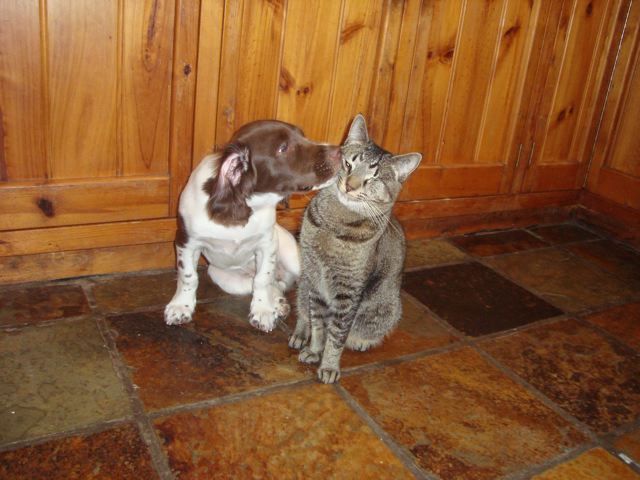
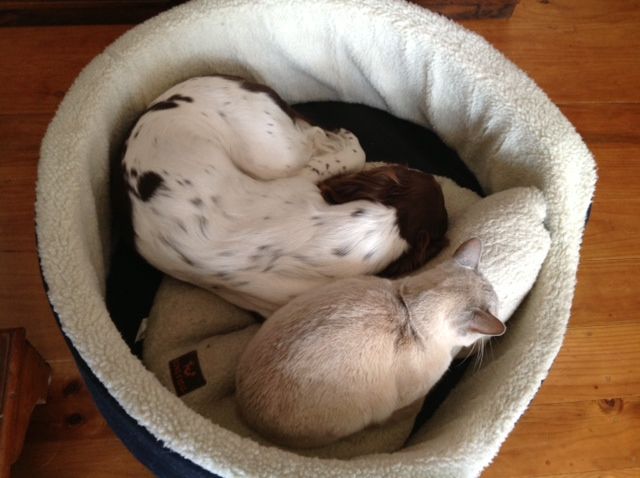
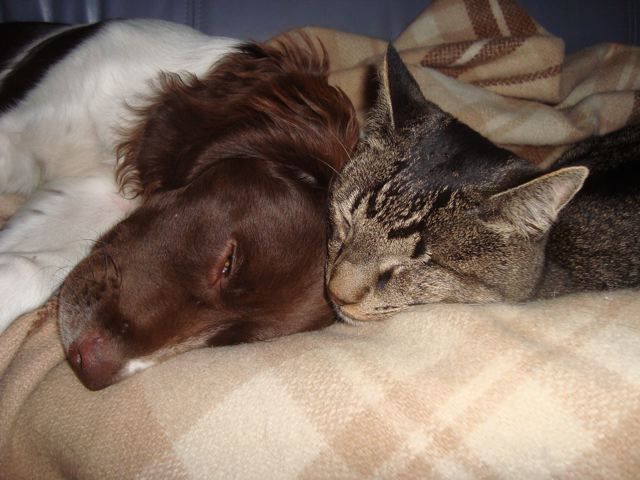
Baby gates (with cat doors) are set up to keep the dogs out of the laundry (and the cat litter!) and out of the hallway (and bedrooms) during the day. This serves three purposes: firstly, the cats have a safe place to disappear to if the dogs get too playful; secondly we can limit access to shoes, socks and cat toys which our Spaniels love to collect; and, thirdly, we can limit the amount of mud that gets tramped around the house in Winter. We use large pens and crates where needed for whelping or in-season bitches or to keep puppies safe or to dry off wet, muddy dogs but limit the time our dogs are contained. Crate training using positive reinforcement (see Susan Garrett's Crate Games DVD for more information) is invaluable - we use crates at competitions, our pups sleep next to our bed in a crate from 8 weeks of age, our dogs cope well if they have to be confined at the vet and it's really handy when we are traveling. Chew resistent beds and wire crates (not soft crates) are highly recommended for at least the first 18 months! As our dogs mature, they graduate to enjoying more freedom and usually end up on our bed at night.
Crate Games Fun for Ginny! from Sally H. on Vimeo.
Are they active dogs? Absolutely! They really do LOVE to run and swim and much prefer to stretch out at top speed rather than walk sedately on a leash. For this reason we work on recall training from a very young age and never become complacent - it not only keeps our dogs safe but it gives them so much more freedom.
Em on the go! from Sally H. on Vimeo.
We like dogs with plenty of drive and instinct so if you don't give them an outlet they will become bored, destructive and even a little obsessive. However, it's not just about physical excercise. It's about mental stimulation - actively training recalls, general manners and boundaries that make for great household pets. We also train our dogs in retrieving, agility, obedience and "tricks" that develop body strength and awareness. It is a rare day indeed that our dogs don't receive some sort of formal training session - even 10 min each of "bodyworks" takes the edge off.
A Little Back End Wobble for Ginny from Sally H. on Vimeo.
We travel quite a bit with our dogs. Of course we are regular entrants in agility and retrieving trials around Victoria and occasionally to NSW, QLD and SA for National competitions, but we also choose to take them with us on camping holidays. Our car has a built in crate to keep them secure and our camping set up has been fine tuned to make holidaying with them a pleasure - they really are fantastic travellers and great fun. We usually travel in the low season and find that, outside school holidays, many more places are happy to welcome well-behaved dogs.
I'm not exactly sure what draws me to the field-bred English Springer Spaniel....they are a breed full of contradictions at times...playful yet deadly serious about their "job"; seemingly boundless energy coupled with an off-switch when needed; they are sweet, snuggly and soft but with a determination to get the job done that belies their size; I love at once their birdiness in the field and their ability to relax with the cats at home; their coat and ears that are prettily feathered but still easy to groom. And let's not forget those beautiful, soulful eyes that look to me attentively for the next "game" and seem to manipulate everyone else!
See what our puppy buyers say:
"The Spaniel is gentle, loving and courteous to man more than any other dog, of free untiring laborsome ranging, beating a full course over and over, which he does with a wanton playing taile and a busie labouring noise, neither desisting nor showing less delight in his labours at night than he did in the morning."
(Richard Surflet, c. 1600s)
© Thornfield English Springer Spaniels 2024
